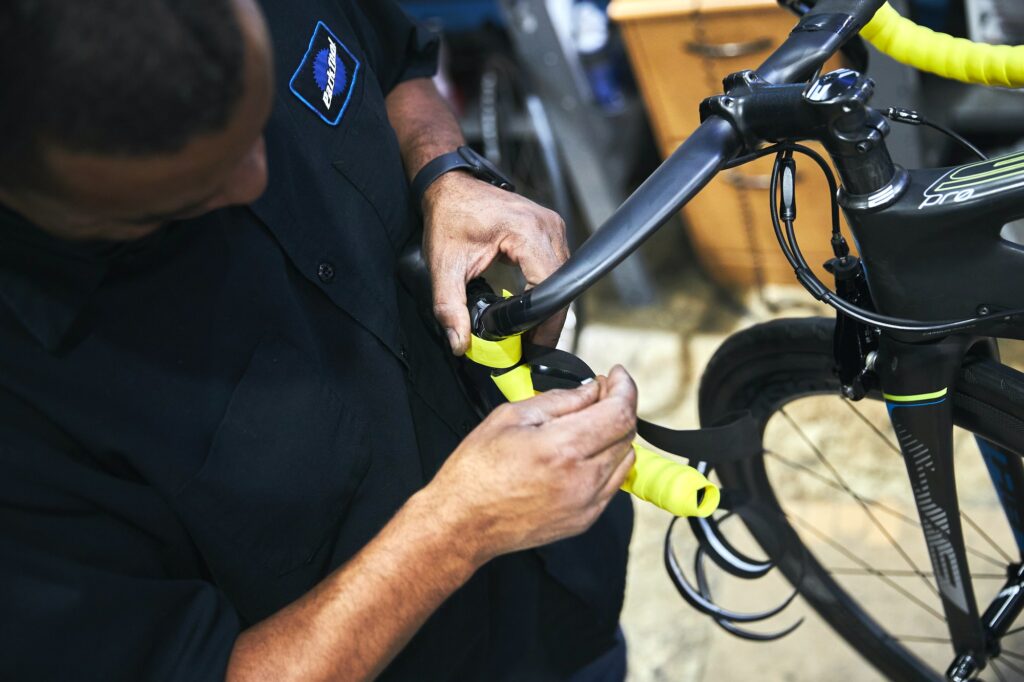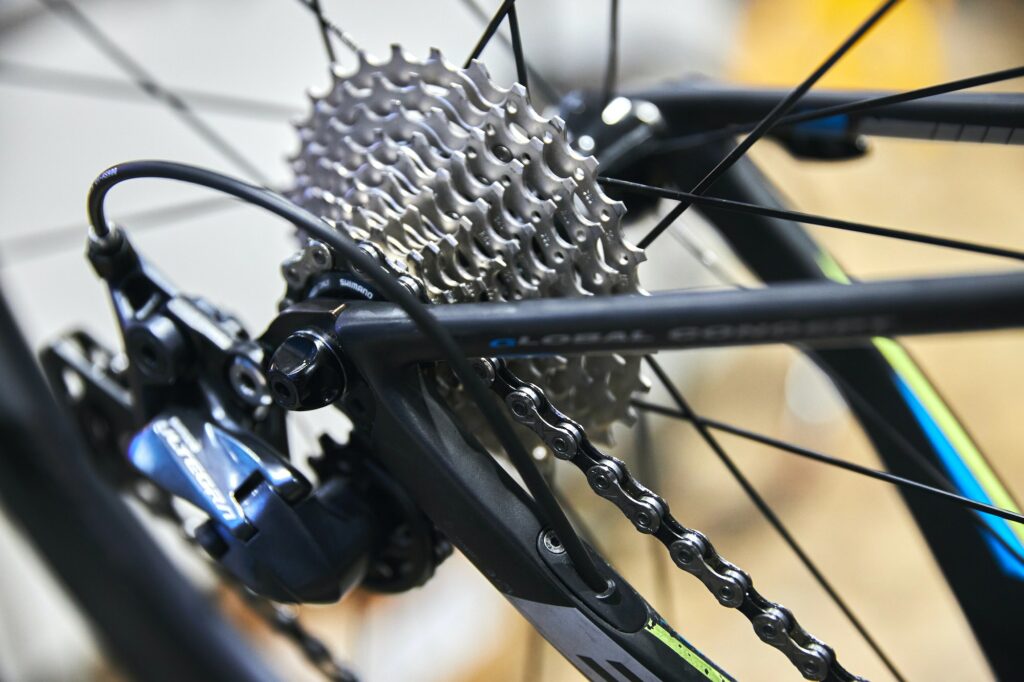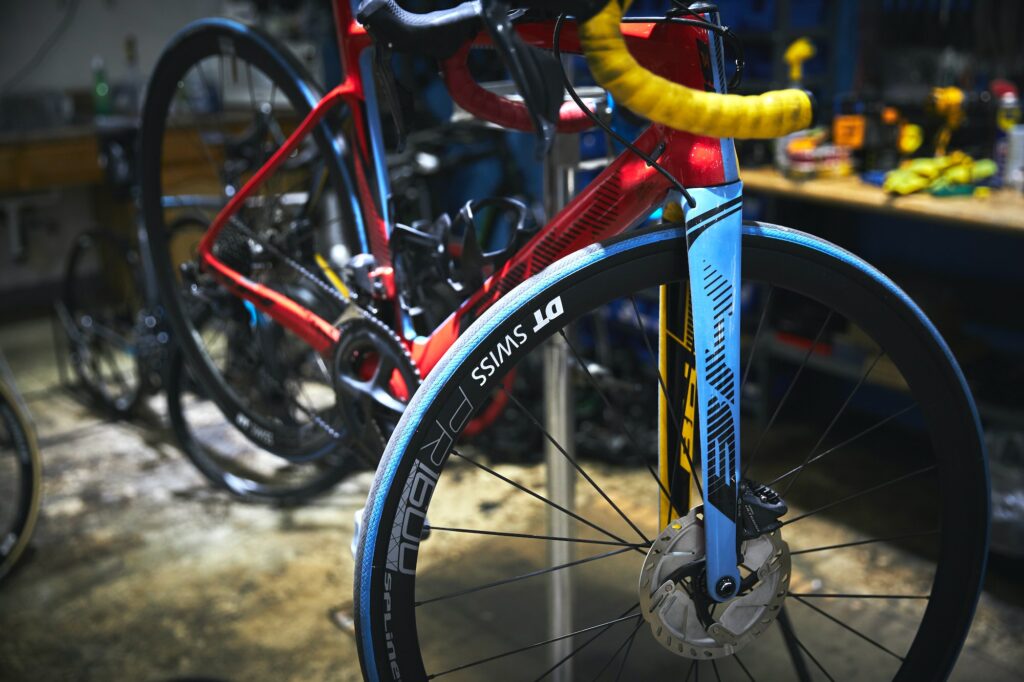Repair shops and mechanics won’t always be around so you have to know the basics of bike repairs
Photos by Taylor Smith/Unsplash
“There’s nothing a good bike ride can’t fix.”
This is a quote I encountered that really stuck to me. Yes, we all enjoy the wind in our hair, the thrill of the descent, and that sense of freedom as we ride our bikes. But what happens when our bike needs fixing? Yes, the easiest way is to bring it to our local bike shop for repairs but this isn’t always the most convenient.
Moreover, what happens if a problem shows up during your ride and you’re stuck in the middle of nowhere? It’s always wise to know a thing or two about bike repairs and bike maintenance.

To start things off, let’s discuss the things we need to bring on a ride:
- Inner tube (one that has a long enough valve)
- Tire levers (get sturdy plastic ones)
- CO2 valve and canister (find a valve with a controlled release function)
- Hand pump (if you don’t want the CO2 for some reason)
- Patch repair kit (useful if you have multiple flats)
- A small pouch or bag to stuff everything in (behind the saddle is usually the best option)
Repairing a flat
Let me start with the most common yet surprisingly most bewildering topic to most: flat repair. Most cyclists would probably use a clincher setup (i.e. with an inner tube) for training rides. The technology around this setup has evolved so much that even some professional triathletes prefer it over the more “race-friendly” setup called tubulars.
To those who are unfamiliar, a clincher setup means that the tire casing is separate from the inner tube; the tire bead is seated on the rim, thanks to tire pressure pumped into the tube.
Think of your bike as an investment. Like all investments, we need to keep an eye on it and give it a little bit of TLC
Tubular tires on the other hand have the inner tube housed inside the actual casing. The tire is then glued on to the rim. We can save the pros and cons of each setup for another day, but most would agree that it all boils down to personal preference. Since repairing a flat tubular is pretty much straightforward, let me discuss the more challenging one: clincher repair.

First and foremost, once you have a flat, it’s important to find a safe flat area that’s not in the way of incoming traffic. Remove your wheel and set your bike safely aside. Begin the repair process as follows:
- Wedge one tire lever in between the rim and tire. Unseat the tire bead (on one side only) by running the lever along the entire rim.
- Remove the valve cover and nut. Find where the puncture occurred and remove the offending object. You can find the puncture by examining the outer casing (you can also run a piece of cloth on the inner side of the casing to see if anything is still protruding) or by inflating the punctured tube slightly and seeing where air leaks (use this as reference for the actual tire). Make sure you do this properly. If you fail to remove the protruding object, your new tube will puncture as well once you pump air in it.
- Unravel your new inner tube (or patch the old one) and pump a little bit of air in the new one (don’t pump too much as it will make reseating harder). This will give the tube some shape and will make it easier to mount. Once you’ve housed the new semi-inflated tube inside the tire casing, the hardest part is next.
- Try and reseat the tire on the lip of the wheel. You’ll find the first few inches easy while the last few inches almost impossible. You make things easier by deflating the inner tube slightly, and/or using a tire lever (carefully) to help flex the tire some more. This is why I like to use softer (i.e. more expensive tires) during races. Not only does it improve grip and rolling resistance, it makes tire changes a lot easier as well.
- Once you’re able to seat the entire tire bead on the rim, give it a quick run-through by checking every inch of the rim. Give it a little squeeze and massage to make sure the inner tube isn’t pinched between the bead and rim.
- Pump air in. The quickest way is to use CO2 but if you prefer to use a hand pump you’re in for an upper body workout. Make sure you don’t get too overzealous with hand pumping as I’ve had valves break from too much flex.
- Remount the wheel, check if the brakes are aligned and you’re (finally) good to go.
Skipping gears or imperfect shifts
With each shift that we make while we ride our bikes, our cables stretch ever so slightly. Over time, the stretch becomes noticeable and this is evident in our bike’s shifting performance. Clicking sounds or an inability to shift is one of the most annoying things that can happen during a ride. Luckily, there’s a simple way to resolve this.
Clicking sounds or an inability to shift is one of the most annoying things that can happen during a ride. Luckily, there’s a simple way to resolve this
Most of the time, stretched cables happen on our rear derailleur (RD). Most RDs have what’s called a barrel adjuster. Barrel adjusters allow you to adjust the tension on your cables without messing with your bolts. Tighten the barrel adjuster by moving it a few rotations clockwise. This is usually enough to adjust most RD problems (repeat if necessary).
For the front derailleur (FD), barrel adjusters are not built in. That’s why I usually ask my mechanic to add an inline barrel adjuster to my cable somewhere along my FD cable. This allows you to make similar adjustments.
Chain maintenance and repair
The bicycle chain is oftentimes the most hard working yet often overlooked piece of equipment on your bike. Imagine the beating it gets with each pedal stroke. That said, do you regularly lube your chain? When’s the last time you checked your chain for stretch? What, our chain stretches?

First things first, adding lube to a chain is not the best way to do it. It’s good for a quick fix-me-up but the best way to do it is to strip your old chain of the old lube (and the dirt and grime mixed in it) and to reapply new lube to a clean chain.
To remove your chain easily, ask your mechanic to install a “missing link” to the chain. This allows you to unlink the chain by using a pair of pliers.
Otherwise, you’ll need a chain breaker (which we’ll discuss later). There are lots of degreasers on the market but a combination of diesel and automotive brake cleaner does the trick. Once your chain is clean, you can either dip it in lube now or remount it on your bike and add drops of lube to each of the chain links. It is important however, to wipe all excess lube on your chain. Remember, we want lube in the links, not on the surface of the chain (this will merely attract dirt and grime).
Like our cables, our chain also stretches with use (and overuse). There’s a simple tool called a chain checker to measure the amount of stretch that has occurred. If you keep using an overstretched chain, your cogs and chainrings will be damaged (albeit with excessive use). You’ll notice a shark’s tooth pattern when this happens. This can also put your chain at a higher risk of breaking.
A broken chain is basically a chain that snaps because one of the links failed. This is a lot more dangerous than you think especially during high torque efforts (i.e. climbing). There’s no surefire way of preventing or predicting when this will happen but proper maintenance (see above) is best. When this happens, you’ll need a chain breaker, which is included in most cycling specific multitools.
If you keep using an overstretched chain, your cogs and chainrings will be damaged (albeit with excessive use)
While YouTube videos can probably best demonstrate how to use it, let me try and do it here. The point of a chain breaker is to dislodge a pin (which is the pivoting joint on the chain). It does this by driving a head (using a screwing motion) on the side of the pin to unseat it.
To reseat it, you just have to drive the pin back into place using the same concept. Of course, a broken chain means removing the broken link, and “shortening” the chain. It’s actually simpler than it sounds but really takes a lot of practice. You can also ask your local neighborhood bike mechanic to teach you.
Fixing the annoying rattling, squeaking or clicking sounds
Rattling is usually because of loose bolts or improperly seated junctions. This is most common on the headset-stem area. If you feel some rattling and wobbling, your headset might not be compressed enough. You will need to loosen your stem’s bolts that clamp on the steerer tube, and compress it down to your headset by tightening your headset cap.
Different brands have different headset caps but usually it’s just a single bolt that you need to tighten. You can check for any more rattling by squeezing your front brake and rocking it front to back. Once you’re happy with it, you can re-tighten the bolts (make sure you use a torque wrench with the proper setting).

Most of the squeaking we notice is because of some buildup of corrosion or oil. This is common in saddle rails or even brake calipers. My advice is to clean it by unmounting, and/or spraying some WD-40 into these crevices. Squeaking brakes is usually due to some oil residue and the best way to resolve this is by either giving it a good wash or spraying some good old brake cleaner on your pads and braking surface (whether rim or disc brake).
Finally, clicking sounds are most common on either our bottom bracket or pedals. Bottom brackets (BBs) are the hardest to solve but usually some grease or retaining compound does the trick. This is more common for non-threaded BBs (e.g. BB90, BB30, BB86 etc.) Clicking sounds on your pedals usually mean that the bearings are shot and that you need to start looking for a replacement. Unlike most of the bearings on a bike, pedal bearings are cartridge-type and cannot be repacked (so you’ll need to replace the whole thing).
Give your bike an overhaul
Probably the most arduous, most unpopular, and most expensive maintenance procedure for your bike is to remove all the little bits and pieces on your bike after a long season (or two). If you are uncomfortable doing this, you can ask your local bike mechanic to do it for you (it does help to watch and understand the process).
Ask them to check for damage, replace corroded bearings or bolts, reapply grease or anti-seize compound to threads, and clean all necessary nooks and crannies. This prevents any headaches on race day and allows you to actually improve the lifetime of your bike (and even possibly improve its resale value).
Think of your bike as an investment. Like all investments, we need to keep an eye on it and give it a little bit of TLC. In the long run, the better we take care of our bikes, the easier it will be to take care of ourselves. Not only will it be safer to ride, it will also make our experience more enjoyable.